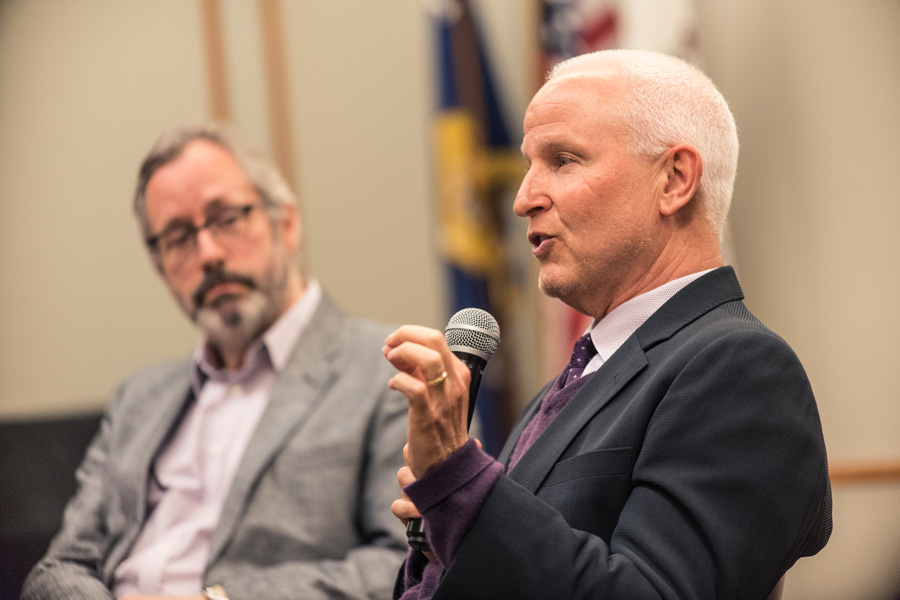Schapiro discusses student debt at Evanston Public Library
Leeks Lim/Daily Senior Staffer
University President Morton Schapiro speaks an event Wednesday about student debt. The event was held at the Evanston Public Library and hosted by the Alice Kaplan Institute for the Humanities.
May 11, 2017
University President Morton Schapiro discussed the rising costs of college at a moderated discussion about the role of student debt in higher education at the Evanston Public Library on Wednesday.
The event, hosted by the Alice Kaplan Institute for the Humanities, also featured Bruce Carruthers, director of the Buffett Institute for Global Studies. It was the final event of Kaplan’s “Debt Dialogues,” a yearlong series of conversations centered on debt.
Schapiro said though there is over $1.3 trillion of student loan debt in the United States, he sees higher education as an investment. He said there is a large economic return on a college degree, citing that an “average person” with a bachelor’s degree makes $70,000 a year.
“There are even people who graduated from highly selective four-year institutions — like Northwestern and Duke and Stanford — who have an enormous amount of debt and are working as baristas and they can’t cover that,” Schapiro said. “But there aren’t too many of them out there.”
Instead, Schapiro said, the highest default rates on debt are concentrated in the for-profit sector of higher education.
Another contributing factor to rising student debt is rising tuition costs, he said. Data reported by U.S. News and World Report indicated that between 1995 and 2015, the average tuition and fees at private national universities jumped 179 percent.
Carruthers, who gave a presentation at the beginning of the event detailing statistics on student debt to contextualize the discussion, said though college “sticker price” has increased dramatically, net price — the price students actually pay including financial aid — has increased less dramatically.
He also said more people have to borrow to pay for college in comparison to a couple decades ago.
“This is not just a story of low-income households having to borrow money; this is true across the board,” Carruthers said. “Everyone — low income, high income, middle income — we’re all borrowing more to go to school.”
The topic of student loans has grown to increasing national significance recently, as in April when Secretary of Education Betsy DeVos withdrew student loan protections put in place by the Obama administration. Those protections required the government’s Federal Student Aid office to do more to help borrowers manage, or even discharge, their debt.
Wednesday’s event was planned by Ph.D. student Casey Caldwell, a Kaplan Institute Franke Fellow who will be teaching a freshman seminar next year on literature and debt. Caldwell told The Daily he thought the event would appeal to both undergraduates and community members.
Caldwell said he thought about how his future students could potentially be impacted by student debt as they sat in his classroom. He said he was pleased with the way the event turned out.
“It’s such a huge topic,” Caldwell told The Daily, “We could have a whole lecture series just on this issue and still barely scratch the surface. For what we could do in an hour and a half I was pretty happy.”
Email: [email protected]
Twitter: @ryanwangman


